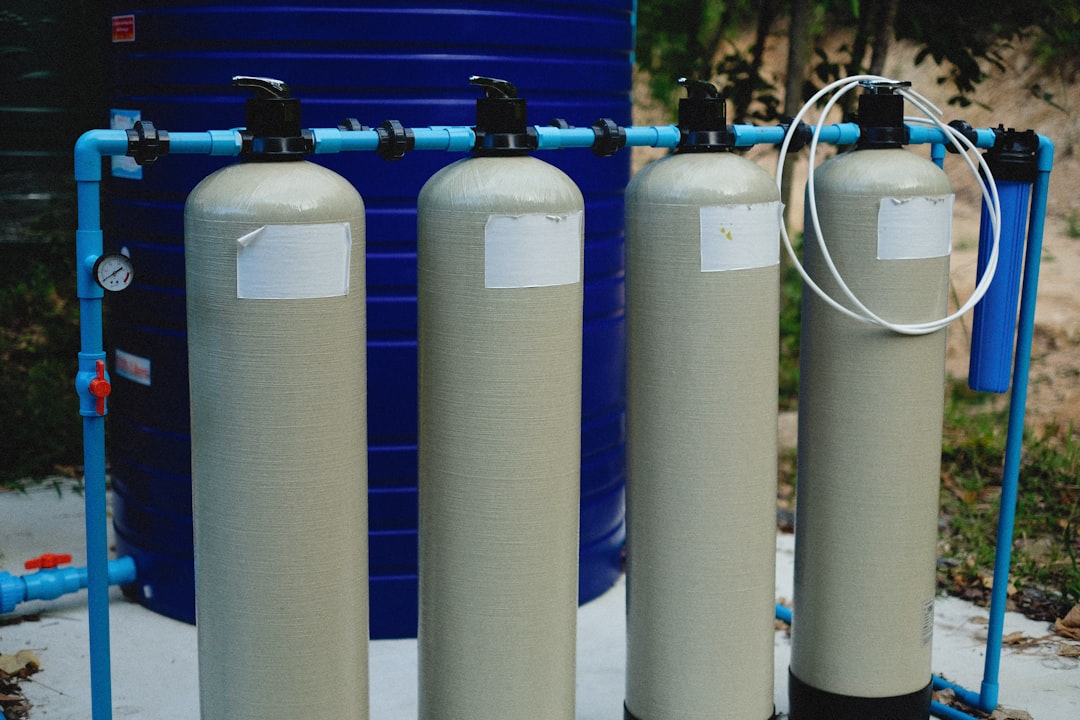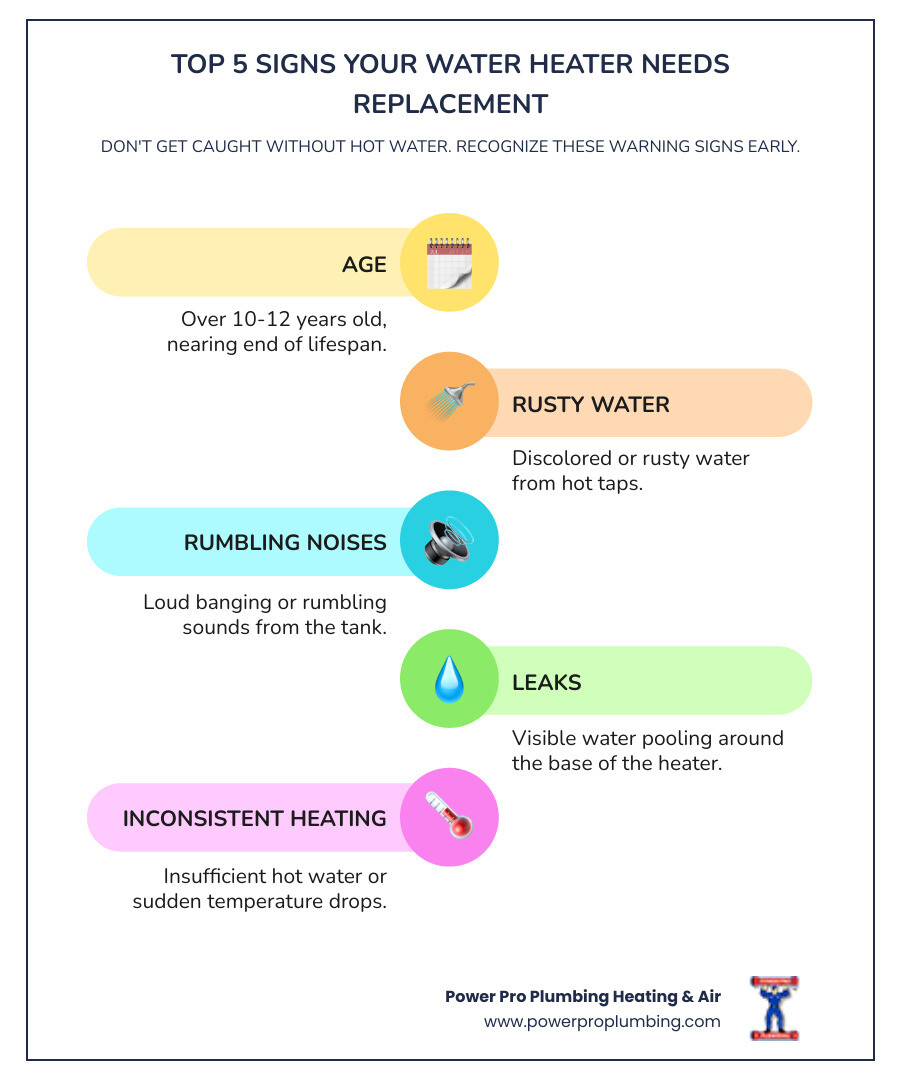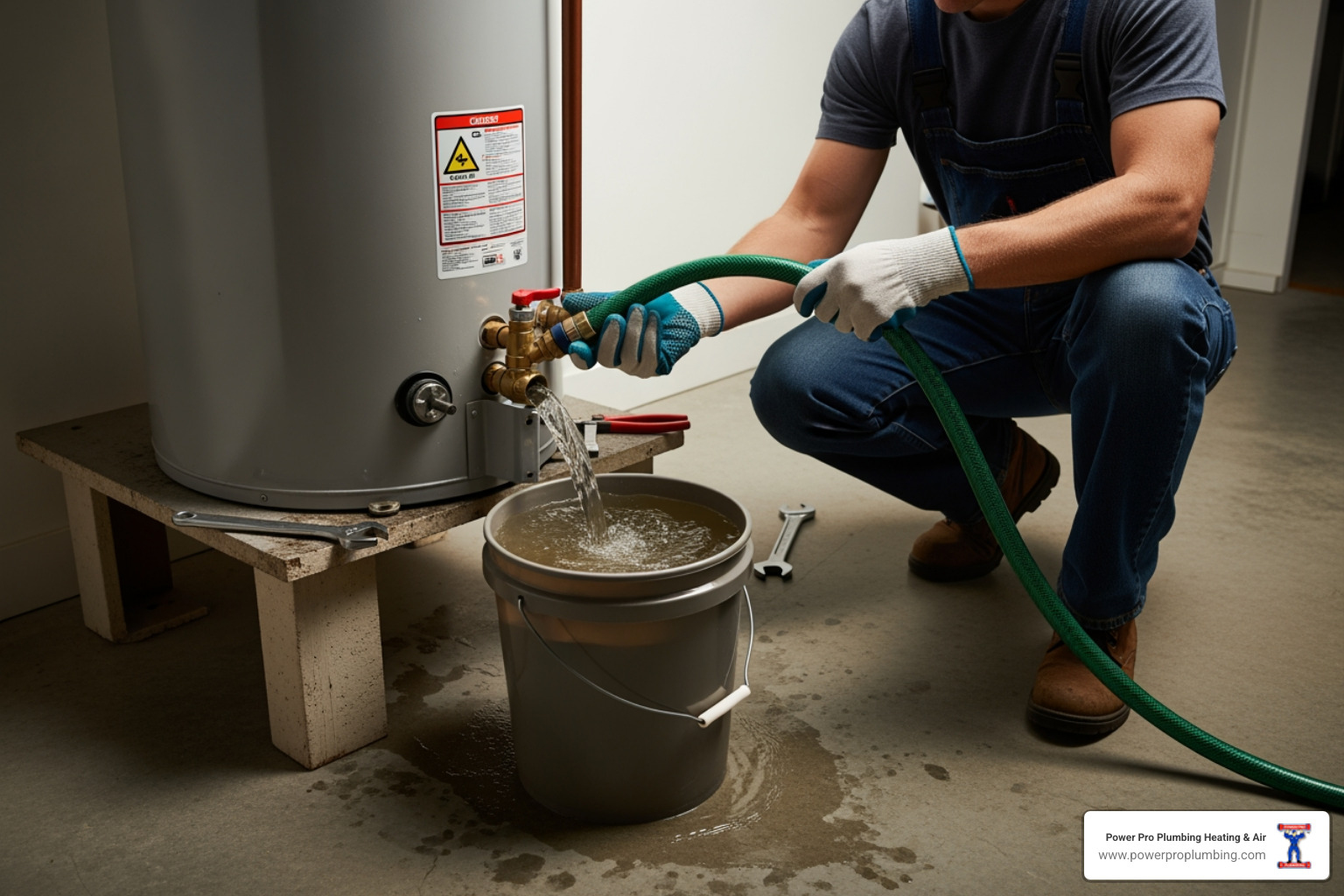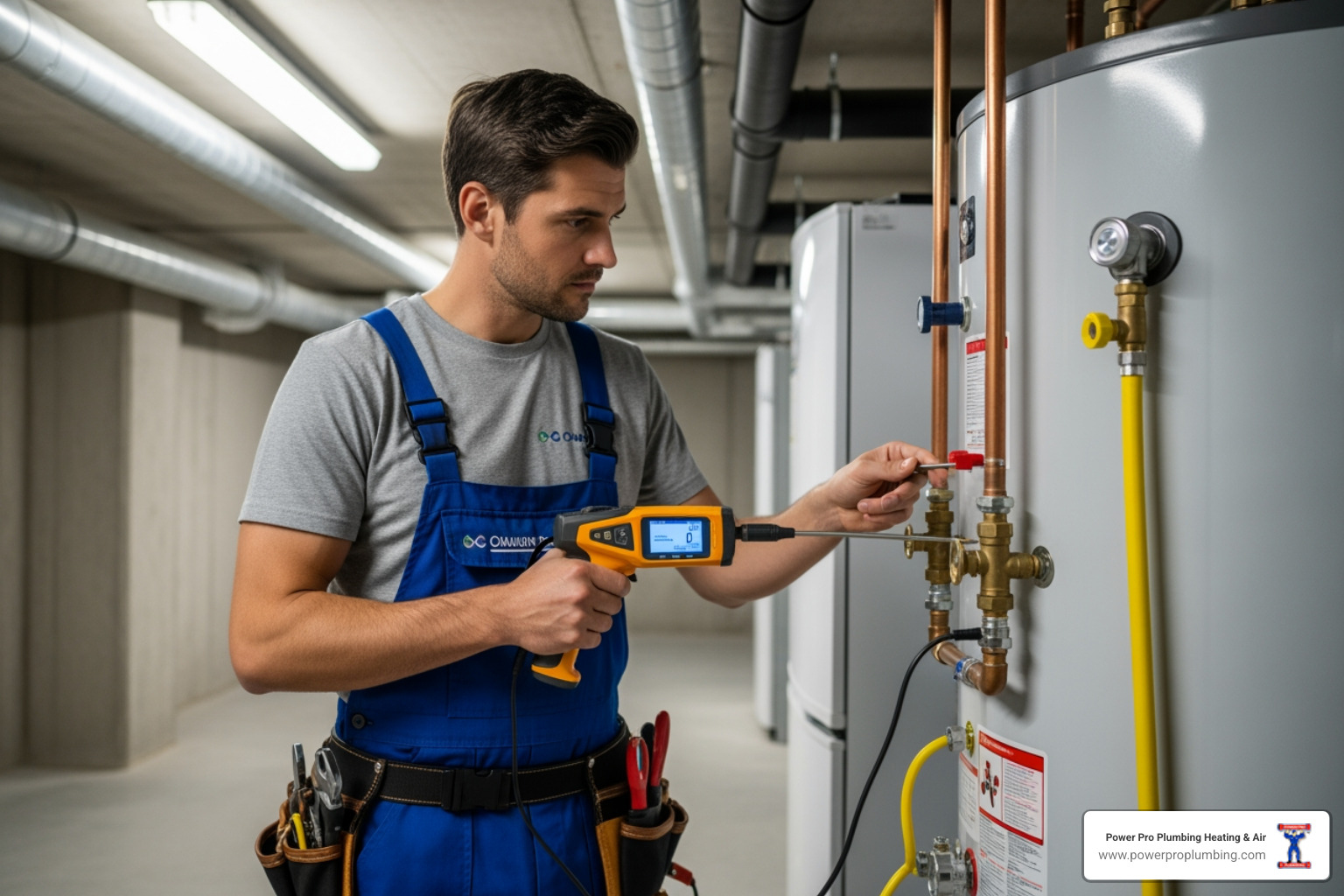
Why Natural Gas Water Heater Installation Matters for Your Home
Natural gas hot water heater installation is a critical project that impacts your comfort, energy bills, and safety. When your water heater fails—delivering lukewarm water, making strange noises, or reaching the end of its 8-12 year lifespan—understanding the installation process helps you decide between repair and replacement.
Quick Answer: Natural Gas Hot Water Heater Installation Overview
- Timeline: Professional installation typically takes 2-4 hours for a standard tank replacement.
- Key Steps: Shut off utilities, drain the old unit, disconnect lines, position the new heater, connect water/gas/vent lines, and test for leaks.
- When to Replace: Age over 10 years, visible rust/leaks, insufficient hot water, or rumbling noises.
- Professional vs. DIY: Gas line work and venting require expertise; professional installation ensures safety and code compliance.
- Average Lifespan: 8-12 years for gas models with proper maintenance.
For comprehensive plumbing solutions in Los Angeles, including water heater services, Power Pro Plumbing Heating & Air provides expert installation and repair. Ready to upgrade your water heater? Schedule a professional installation consultation today.
Installing a natural gas water heater involves working with gas lines, combustion venting, and water connections, all of which must meet strict local building codes. Due to the complexity and risks of improper venting or gas connections, professional installation is the recommended route. While tank-style water heaters are common, tankless models are gaining popularity for their energy efficiency and compact design.

Preparing for Your Water Heater Replacement
Most people don't think about their water heater until a cold shower or a puddle in the utility closet forces them to. The good news is that your unit usually provides warning signs before it fails completely.
Understanding When It's Time for Replacement
Most tank-style water heaters last 8-12 years. If yours is approaching this age, it's wise to plan for a replacement. Key warning signs include:
- Rusty water from hot taps, indicating internal tank corrosion.
- Rumbling or popping noises, caused by sediment buildup hardening at the bottom of the tank, which reduces efficiency.
- Visible leaks around the base, which may signal a crack in the tank requiring immediate replacement to prevent water damage.
- Inconsistent temperatures or running out of hot water, meaning the heater can no longer meet your household's demand.
Selecting the Right Water Heater for Your Home
Choosing the right unit is crucial. Capacity is a primary factor; a 30-40 gallon tank is often sufficient for 1-2 people, while larger families may need 50-80 gallons. That newer models are often wider and taller due to increased insulation requirements, so measure your space before buying.
The Energy Factor (EF) rating indicates how efficiently the heater operates—a higher number means lower energy bills. The recovery rate measures how quickly it can heat a new tank of water, an important feature for busy households.
Tankless models are an alternative, heating water on-demand for an endless supply. They are highly energy-efficient but have a more complex installation process. Tankless natural gas hot water heater installation often requires upgrading gas lines and installing specialized venting systems.
| Feature | Tank-Style Water Heater | Tankless Water Heater |
|---|---|---|
| Hot Water Supply | Stores and heats a limited amount of water | Heats water on demand, endless supply |
| Energy Efficiency | Heats water continuously, even when not in use | Highly efficient, heats only when needed |
| Installation | Simpler, often direct replacement for existing units | More complex, may require gas line and venting upgrades |
| Size/Space | Large, bulky tank | Compact, wall-mounted unit |
| Lifespan | 8-12 years (gas) | 15-20+ years |
| Venting | Typically conventional chimney or power vent | Direct-vent only, specialized venting required |
| Gas Line Requirements | Standard gas line | Larger gas line often required (higher BTU input) |
Essential Tools and Materials for the Job
While we recommend professional installation for any natural gas hot water heater installation, understanding the requirements highlights the job's complexity. A professional will use specialized tools like pipe wrenches, a tubing cutter, and a gas torch for soldering.
Materials include gas-rated plumber's thread tape, new flexible gas and water connectors, various copper fittings, lead-free solder, and proper vent piping. The complexity of working with these materials and meeting local codes is why most homeowners trust a professional. For expert water heater installation in Los Angeles, Power Pro Plumbing Heating & Air has the experience and tools to do the job safely and efficiently.
A Homeowner's Guide to Natural Gas Hot Water Heater Installation
This overview covers the general steps for a natural gas hot water heater installation. This is a complex task involving gas, water, and electricity where safety is paramount. If you are not comfortable with any step, especially gas lines, it's best to call the professionals at Power Pro Plumbing Heating & Air.

Step 1: Preparation and Removal
The process begins by shutting off the gas and water supply to the heater. For units with power vents or electronic ignition, the electricity is also turned off at the circuit breaker. A garden hose is attached to the drain valve to empty the tank. Once drained, the water lines, gas line, and vent pipe are disconnected using pipe wrenches, and the old, heavy unit is carefully removed.
Step 2: Positioning and Connecting the New Heater
The new water heater is moved into place, ensuring adequate clearance for ventilation and service. It must be perfectly leveled using a bubble level and shims. A drain pan is placed underneath as required by code. New flexible connectors are typically used for the water lines. The gas line connection is the most critical step, requiring proper sealing with gas-rated plumber's thread tape, installation of a drip leg (sediment trap), and careful tightening to prevent leaks.
Key Differences for a Tankless Natural Gas Hot Water Heater Installation
Installing a tankless natural gas hot water heater is significantly more complex and almost always requires a professional. Key differences include:
- Gas Line Upgrade: Tankless units have high BTU requirements, often necessitating an upgrade to a larger-diameter gas line from the meter.
- Specialized Venting: They cannot use a standard chimney and require a dedicated vent kit, often made of stainless steel or PVC, that is routed directly through a wall or roof.
- Electrical and Mounting: Tankless heaters are wall-mounted and require a sturdy surface and a nearby electrical outlet to power their electronics.
Final Connections and Testing
This is the most critical phase for safety. The vent pipe is securely connected to ensure proper exhaust of combustion gases. A new Temperature & Pressure (T&P) relief valve is installed with a discharge line running to a safe location. The tank is then filled with water, and air is bled from the lines by opening hot water faucets.
The most important safety check is testing for gas leaks. After slowly turning the gas on, a detection solution is applied to all new connections. Any bubbling indicates a leak that must be fixed immediately. A professional may also use a pressure test gauge for verification. Finally, a draft test is performed on tank-style units to ensure gases are venting properly. Once all tests are clear, the pilot is lit, and the thermostat is set to a safe temperature, typically 120°F to prevent scalding.
Critical Safety Measures, Codes, and When to Call a Pro
With natural gas hot water heater installation, safety is the top priority. The dangers of working with natural gas and combustion appliances are real, making professional expertise essential.

Gas Leaks and Carbon Monoxide Risks
Natural gas is flammable, and even a small leak can be dangerous. If you ever smell the "rotten egg" odor of gas, evacuate immediately and call your gas provider from a safe distance. Carbon monoxide (CO), a byproduct of combustion, is an even more insidious threat because it is odorless and colorless. Proper ventilation is non-negotiable to prevent CO from entering your home. The venting system must be correctly sized and installed to exhaust all combustion gases outside. Additionally, the water heater needs adequate combustion air (oxygen) to burn fuel safely and efficiently, a requirement detailed in the International Plumbing Code.
Preventing Scalding and Navigating Codes
Water temperatures above 120°F can cause severe burns. Setting the thermostat to 120°F is a crucial safety measure. For added protection, thermostatic mixing valves can be installed to deliver a safe temperature at the tap while allowing the tank to store water at a higher temperature to prevent bacterial growth.
Water heater installations are governed by strict local building codes that dictate everything from placement and clearance to gas line sizing and earthquake strapping. A permit is almost always required, ensuring an inspector verifies the work meets all safety standards. Our technicians at Power Pro Plumbing Heating & Air are familiar with the specific codes throughout Los Angeles and surrounding areas, ensuring every installation is compliant.
When DIY Becomes Too Risky
While DIY projects can be rewarding, a gas water heater installation is not the place to learn on the job. You should always call a professional if the job involves:
- Gas line modifications: Incorrectly sized or connected gas lines can lead to leaks, fires, or explosions. This is especially true for tankless heaters requiring larger lines.
- Complex venting: Ensuring proper draft and safe termination of vent pipes is a life-or-death matter that requires expertise.
- Code uncertainty: A professional plumber knows the specific, complex codes for your municipality, ensuring your installation is safe and will pass inspection.
Given the risks, the physical demands of moving a heavy unit, and the technical skill required, hiring a licensed professional provides peace of mind that the job is done right.
Post-Installation Care: Maintenance and Troubleshooting
Your new natural gas hot water heater installation is complete, but regular maintenance is key to ensuring its longevity and efficiency. A small investment in care can prevent costly future repairs.

Best Practices for Longevity:
- Annual Professional Inspections: A yearly checkup of connections, the burner, venting, and safety valves can catch minor issues before they become emergencies. Our Power Pro Club members receive these inspections as part of their membership.
- Flush the Tank: Draining a few gallons from the tank every six months removes sediment buildup, which improves efficiency and prevents noise.
- Check the Anode Rod: This "sacrificial" rod protects your tank from rust. It should be inspected annually and replaced when depleted to extend the life of the tank.
- Test the T&P Relief Valve: Once a year, test the Temperature & Pressure valve to ensure this critical safety device is functioning correctly.
Common Problems and Troubleshooting:
- No Hot Water: Check that the pilot light is lit and the gas valve is open. Ensure the thermostat is set correctly.
- Insufficient Hot Water: This is often caused by sediment buildup reducing tank capacity or a thermostat set too low. Your household's needs may have also outgrown the tank's size.
- Rumbling or Popping Noises: This almost always indicates sediment at the bottom of the tank. Flushing the tank is the solution.
- Leaks and Drips: Check connections for tightness. A dripping T&P valve may indicate high pressure or a faulty valve. Water leaking from the tank body itself means the unit must be replaced.
- Pilot Light Keeps Going Out: This could be caused by a draft, a dirty pilot orifice, or a failing thermocouple.
If basic troubleshooting doesn't solve the problem, or if you suspect a gas or CO issue, turn off the gas and call Power Pro Plumbing Heating & Air immediately. Our technicians can diagnose and repair any issue safely and quickly.
Frequently Asked Questions about Gas Water Heater Installation
Homeowners often have questions about natural gas hot water heater installation. Here are answers to some of the most common ones.
How long does a typical natural gas water heater last?
A typical tank-style gas water heater has a lifespan of 8 to 12 years. Longevity is heavily influenced by water quality and, most importantly, regular maintenance. Annual flushing and anode rod inspections can significantly extend the unit's life. You'll know it's nearing the end of its life if you see rusty water, hear rumbling noises, find leaks, or consistently run out of hot water. If your unit is over 10 years old and showing these signs, it's time to plan for a replacement.
What size water heater do I need for my home?
Choosing the right size is crucial for meeting your needs without wasting energy. For tank-style heaters, sizing is based on:
- Household Size: A 30-40 gallon tank may work for 1-2 people, while a family of 4 may need a 40-50 gallon unit.
- Peak Hot Water Usage: Consider how many bathrooms and appliances might be used at once.
- First Hour Rating (FHR): Found on the EnergyGuide label, this number tells you how many gallons of hot water the unit can produce in an hour of peak demand. Matching the FHR to your needs is the best way to ensure you have enough hot water.
For tankless heaters, sizing is based on the required flow rate and temperature rise, a more technical calculation best handled by a professional.
How is a natural gas hot water heater installation different from an electric one?
While they both heat water, the installation processes are very different, with gas installations being more complex. The key distinctions are:
- Fuel Source: Gas heaters connect to a gas line, while electric heaters connect to a high-voltage electrical circuit.
- Venting: Gas heaters produce combustion byproducts like carbon monoxide that must be vented safely outside. Electric heaters produce no emissions and require no venting.
- Gas Line Work: A gas installation requires specialized work, including installing shut-off valves, drip legs, and testing every connection for leaks.
- Combustion Air: Gas heaters need a constant supply of fresh air to operate safely, which can affect where they are installed. Electric heaters have no such requirement.
These differences in gas work and venting are why professional installation is strongly recommended for all natural gas water heaters.
Conclusion
We've covered the essentials of natural gas hot water heater installation, from identifying the need for a new unit to understanding the installation process. It's clear that this is a complex job where safety, code compliance, and technical skill are paramount. The risks associated with natural gas and combustion venting underscore why this is a project best left to professionals.
Whether you choose a traditional tank or a high-efficiency tankless model, the quality of the installation will affect your home's safety and comfort for years. At Power Pro Plumbing Heating & Air, our licensed technicians bring years of experience to every installation across the greater Los Angeles area. We know the local codes and are committed to doing the job right, backed by over 28,573 online reviews and our Power Pro Club maintenance program.
Your family deserves reliable hot water and the peace of mind that comes from a safe, professional installation. When you're ready to upgrade your system, we're here to help.

